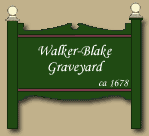
Carvers
Carvers
Backrounds of the Gravestone Carvers
Backrounds of the Gravestone Carvers
Carvers
Backrounds of the Gravestone Carvers

history
Origins of the Graveyard
The graveyard began out of necessity by James Walker, Sr. upon the death of his wife. Elizabeth Walker, the wife of James, died on August 14, 1678. The graveyard was located on his land. The graveyard probably had burials previous to 1678, but there are no markers or records to verify same. The graveyard is located on a rise that overlooks the Taunton River. The graveyard is about the size of a football field. The boundary of the graveyard is denoted by a stonewall. There are about 169 people buried in the graveyard. The last burial was Mercie Palmer Blake who died December 12, 1912. Most of the graves have footstones as well as their headstones. This is not always the case in old graveyards because early graveyard grounds keepers discarded footstones as too much additional work to cut grass around. The Walker-Blake Graveyard has been known by many names over the centuries. I call it the Walker-Blake Graveyard because it was called “ “Walker-Blake” in “INSCRIPTIONS from Eleven Cemeteries in Taunton” compiled by Mrs. Wendell B. Presbrey, Historian, Lydia Cobb Chapter Daughters of the American Revolution. In the 1800’s, the graveyard was called the “Walker Burying Ground” by Edgar Hodges Reed. The Pendleton family called the cemetery the Rose Cemetery. It has also been known as the Richmond Graveyard.
The graveyard is probably the second oldest graveyard in Taunton. The Walker-Blake Graveyard has six markers from the seventeenth century. The oldest burial ground is the Neck-O-Land Burial Ground on Summer St. that is close to the center of the original settlement and has some number of burials without markers.